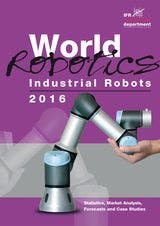The International Federation of Robotics (IFR; Frankfurt, Germany), in it's latest annual survey, says that by 2019, more than 1.4 million new industrial robots will be installed in factories around the world, to a total of about 2.6 million. In the race for automation in manufacturing, the European Union is currently one of the global frontrunners with 65% of countries with an above-average number of industrial robots per 10,000 employees. However, in 2019 some 40% of the worldwide market volume of industrial robots will be sold in China.
"Automation is a central competitive factor for traditional manufacturing groups, but is also becoming increasingly important for small and medium-sized enterprises around the world, " says Joe Gemma, President of the IFR. Approximately 70% of industrial robots are currently at work in the automotive, electrical/electronics, and metal and machinery industry segments. In 2015, the strongest growth in the number of operational units was in the electronics industry, with a rise of 18%.
The strongest growth figures in Europe were in the Central and Eastern European states--the rise in sales was about 25% in 2015. Also 2016 a similar growth rate is forecasted (29%). Half of the top 10 nations with the most industrial robots per 10,000 employees belong to the European Union. The robot density in the big Western European economies is currently ahead of fast-growing China.
China, the market for growth
With a national 10-year plan titled "Made in China 2025", China intends to become one of the top industrial nations. However, to achieve Beijing's target of a robot density of 150 units by 2020, some 600,000 to 650,000 new industrial robots will have to be installed. By comparison, about 254,000 units were sold in the entire global market in 2015.
China is already a leading robot market, with sales of around 68,600 units. The statistics for 2015 were 20% above the previous year's figures, exceeding the sales volume for all European markets combined (50,100 units). Total sales will increase by 30% in 2016 and, between 2016 and 2019, by 20% on average to more than 400,000 units in 2019. This will be 40% of the total sales in 2019.
The Korea and Japan come in second and third place, as the world's largest markets for industrial robots. The number of units sold in 2015 grew by 55% in Korea, and by 20% in Japan. Together with Singapore, these two countries lead the rankings of the global automated economies for robot density in manufacturing. Korea and Japan should see average annual growth of 5% in sales of robots from 2016 to 2019.
North America, a strong market
The USA is the fourth largest single market for industrial robots in the world. Within the NAFTA area (USA, Canada, and Mexico), the total number of newly installed industrial robots rose by 17% to a new record of some 36,000 units (2015). The USA accounted for three-quarters of all units sold, with 5% growth. 5% growth recorded. Demand in Canada increased by 49% (5,466 units), while that in Mexico grew by 119% (3,474 units). North America should see average annual growth of 5 to 10% in sales of robots from 2016 to 2019.
The USA has focused on automating the automotive industry, with US car makers ranked third in robot density behind Japan and Korea. The US automotive industry has performed well over the last six years, and 2015 proved to be the most successful year since 2005. Major manufacturers from the US, Europe, and Asia embarked on restructuring programmes resulting in the installation of some 80,000 industrial robots between 2010 and 2015. This is the largest investment worldwide, second only to China at around 90,000 units. The number of people employed in the automotive sector grew by around 230,000 between 2010 and 2015.
Outlook 2019
By the end of 2016, the number of newly installed industrial robots will have increased by 14% to 290,000 units during the year. For 2017 to 2019, continued growth averaging at least 13% per year is forecasted (CAGR). Robotics manufacturers have made preparations for these kinds of growth prospects. To this end, production capacities have been increased, and the majority of European manufacturers are operating new locations in the large sales markets of China and the USA.
In the future, companies will be concentrating on the collaboration of human and machine, simplified applications, and light-weight robots. Added to this are the two-armed robots, mobile solutions, and the integration of robots into existing environments. There will be an increased focus on modular robots and robotic systems, which can be marketed at extremely attractive prices.
The demand among customers for industrial robots will likewise be driven by many diverse factors, including the handling of new materials, energy efficiency, better developed automation concepts, enabling the real-world factory, and the virtual world to be interlinked with one another, as per the definition of Industry 4.0 and the Industrial Internet of Things.

